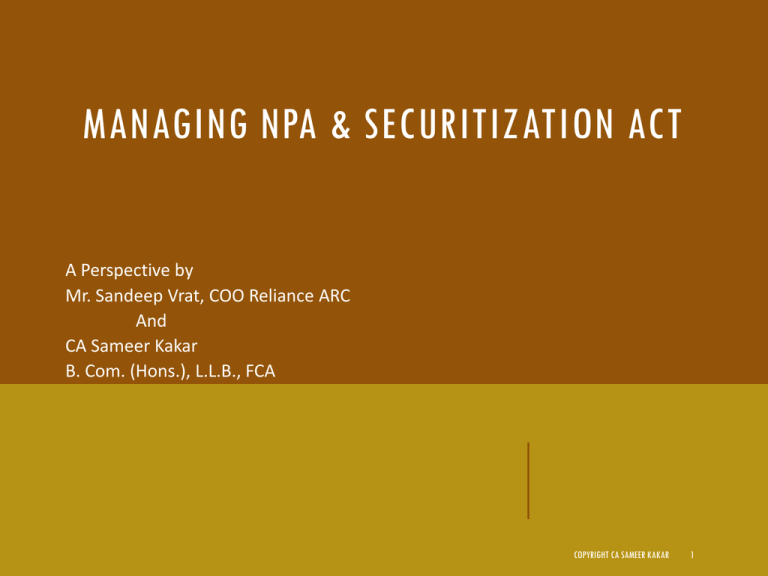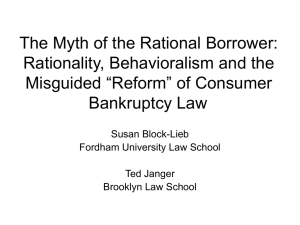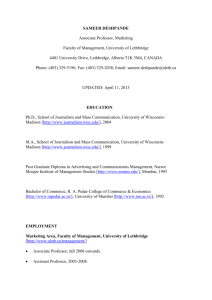Presentation
advertisement

MANAGING NPA & SECURITIZATION ACT A Perspective by Mr. Sandeep Vrat, COO Reliance ARC And CA Sameer Kakar B. Com. (Hons.), L.L.B., FCA COPYRIGHT CA SAMEER KAKAR 1 CONTENTS NPA Generally Options available to borrowers post NPA CDR Securitization Act ARC COPYRIGHT CA SAMEER KAKAR 2 MAGNITUDE OF NPA As per RBI publication amounts blocked in NPA as on 31.3.12 were close to Rs. 1.37 lakh crore In June, 2013 ICRA has estimated that due to economic slow down and recent changes by RBI in Prudential Norms Gross NPA may reach 5.5% to 6.5% by Mar. 15, NPA are bye products which are generated by banks in banking business COPYRIGHT CA SAMEER KAKAR 3 DEFINITION OF NPA As per RBI Circular no. DBOD.No.BP.BC.9 /21.04.048/2012-13 dated July 2, 2012 (master circular) :An asset, including a leased asset, becomes nonperforming when it ceases to generate income for the bank. A non performing asset (NPA) is a loan or an advance where; interest and/ or instalment of principal remain overdue for a period of more than 90 days in respect of a term loan, the account remains ‘out of order’ in respect of an Overdraft/Cash Credit (OD/CC), the bill remains overdue for a period of more than 90 days in the case of bills purchased and discounted, the instalment of principal or interest thereon remains overdue for two crop seasons for short duration crops, the instalment of principal or interest thereon remains overdue for one crop season for long duration crops, the amount of liquidity facility remains outstanding for more than 90 days, in respect of a securitisation transaction undertaken in terms of guidelines on securitisation dated February 1, 2006. in respect of derivative transactions, the overdue receivables representing positive mark-to-market value of a derivative contract, if these remain unpaid for a period of 90 days from the specified due date for payment. COPYRIGHT CA SAMEER KAKAR 4 OUT OF ORDER If the outstanding balance remains continuously in excess of the sanctioned limit/drawing power. In cases where the outstanding balance in the principal operating account is less than the sanctioned limit/drawing power, but there are no credits continuously for 90 days as on the date of Balance Sheet or credits are not enough to cover the interest debited during the same period, these accounts should be treated as 'out of order'. COPYRIGHT CA SAMEER KAKAR 5 DEFINITION CONTD…. Projects under implementation which have passed their Date of Commencement of Commercial Operations (DCCO) For Infrastructure Projects If financial closure achieved & documented a period not exceeding 2 years from the date of completion envisaged at the time of financial closure. If financial closure not achieved, 2 years from the date of completion envisaged at the time of sanction. In case of PPP projects shift in appointed date not to be considered as restructuring in certain cases. Other Projects One Year from the date of completion envisaged at the time of financial closure but within 2 years of the original DCCO. COPYRIGHT CA SAMEER KAKAR 6 NPA DEFINED UNDER SARFEASI ACT As per sec 2 (o) "non-performing asset" means an asset or account of a borrower, which has been classified by a bank or financial institution as sub-standard, doubtful or loss asset,-(a) in case such bank or financial institution is administered or regulated by any authority or body established, constituted or appointed by any law for the time being in force, in accordance with the directions or guidelines relating to assets classifications issued by such authority or body; (b) in any other case, in accordance with the directions or guidelines relating to assets classifications issued by the Reserve Bank; COPYRIGHT CA SAMEER KAKAR 7 WHAT ARE COVERED UNDER NPA Working Capital Term Debt Crop Loans Other facilities • Cash Credit Limits. • Letters of Credit/Guarantee • Bills Discounted & Purchased • Industrial Term Loans • Infrastructure Term Loans • Short Term • Long Term • Derivative Transactions COPYRIGHT CA SAMEER KAKAR 8 WHAT ARE NOT COVERED Reference made to BIFR where the borrower is making regular payments Consortium Advances where one of the bank has classified the account as NPA and the account is standard with other banks Same for accounts under Multiple Banking COPYRIGHT CA SAMEER KAKAR 9 CATEGORIES OF NPA Category Period from NPA date Provisioning requirement Substandard 12 months 15% if secured. 25% if unsecured. Doubtful > 12 months 1 Yr. 25% 1 to 3 Yr. 40% > 3 Yr. 100% Loss Uncollectable 100% COPYRIGHT CA SAMEER KAKAR 10 GENERAL PROVISIONING ON NPA Present guidelines provide for provisioning @ 2.75% in case of restructured accounts. As per recent circular of RBI such provisioning is required to be enhanced to 5% in phased manner as per table below :Effective date 31/03/2014 (spread over 4 quarters of 13-14) Provisioning % 3.5 31/03/2015 (spread over 4 quarters of 14-15) 4.25 31/03/2016 (spread over 4 quarters of 15-16) 5.00 COPYRIGHT CA SAMEER KAKAR 11 RECENT CHANGES IN SPECIFIED PERIOD FOR UP-GRADATION OF ACCOUNT Vide circular No. DBOD.BP.BC.No.99/ 21.04.132/2012-13 dated May 30, 2013 RBI has changed certain norms regarding specified period. All restructured accounts which have been classified as NPA and which have been restructured, are eligible for up-gradation to the ‘standard’ category after observing satisfactory performance during the specified period. Specified period in this regard hitherto meant a period of one year from the date when the first payment of interest or instalment of principal falls due under the terms of restructuring package. As per the latest circular of RBI “Specified period” is now redefined as a period of one year from the commencement of the first payment of interest or principal, whichever is later, on the credit facility with ‘longest period of moratorium under the terms of restructuring package’. COPYRIGHT CA SAMEER KAKAR 12 SOME REASONS FOR SICKNESS Short Term Medium Term Long Term Force majure Business Cycle Locational Judgement errors Technological Shift Obsolescence Government Policies Incompetence Financial mismanagement COPYRIGHT CA SAMEER KAKAR 13 CURATIVE MEASURES “My money is out, I have no control over the money any more, only security- I have to have a pragmatic & practical approach……..Head of Recovery & Legal of a well known Bank Tweaking the limits - mainly WC to Supply Bill, Margin reduction, conversion to LAP, Term Loan etc……. Resolution of operational difficulties ASAP Outside support – talking to creditors/debtors, competitors, suppliers, agents, technology suppliers etc…. Close watch on banking operations Merger/acquisitions – leads given to close advisors Regular review of portfolio for identification of potential NPA and follow up COPYRIGHT CA SAMEER KAKAR 14 OPTIONS AVAILABLE POST NPA “Doing business without Debt is like fish without water” “The first step for solving a problem is to realize that there is a problem” Borrower Lender Restructuring Restructuring One Time Settlement One Time Settlement Reference to BIFR Sale/Assignm ent to ARC Deferring the Decision Recovery through DRT Enforcement under SARFEASI COPYRIGHT CA SAMEER KAKAR 15 RESTRUCTURING – AVAILABLE MEANS Restructuring is “Novation” u/s 62 of the Indian Contract Act - new terms are substituted for the old. Bilateral • Borrower & Lender agree to certain terms • New terms substitute old terms CDR • A forum of lenders under aegis of RBI • Highly effective • Suitable where multiple lenders are involved BIFR • Under provisions of SICA • Order has binding powers Court • U/s 391-compromise and arrangement COPYRIGHT CA SAMEER KAKAR 16 CDR CDR – a forum at the aegis of RBI Debtor Creditor agreement (DCA) and Inter Creditor Agreement (ICA) are legal basis Various committees like Core Group, Standing Committee, Empowered Group, Monitoring Comm. etc CDR Cell Multiple banks necessary Minimum amount Rs. 20 Cr. Super majority is basis for decision i.e. 75% in value and 60% in number Decision binding on minority (less than 25%) Reference generally by leader, other cases any other lender with min. 20% of total exposure Highly effective –debt restructured Rs. 2.29 lakh Crore in 401 cases upto 31.03.13 COPYRIGHT CA SAMEER KAKAR 17 PROCESS AT CDR Borrower facing financial difficulty • Board to take cognizance • Preparation of preliminary plan • Presentation to Lead Bank Lead Bank • To discuss the plan with the borrower. • Take approval from sanctioning authority (stand note) • Reference is made to CDR (Flash) CDR Flash • CDR Cell analyzes the Flash. • Circulation is made to all lenders • Flash is deliberated at the CDR EG • Put to vote, in case proposal is approved with super majority, next step CDR Final • Final report is prepared by Lead Bank. • Presented to CDR Cell for comments. • Circulation amongst lenders. • Discussion at CDR EG, • Voteapproval/modific ation/rejection. • Issue of sanction by CDR Cell on borrower. • All banks to provide individual sanction to borrower. • Monitoring Mechanism COPYRIGHT CA SAMEER KAKAR 18 SOME SPECIAL TERMS IN CDR Right to Recompense Interest Reset Milestone for repayment/release of security Escrow account and water fall mechanism for payments Appointment of key personal such as CEO, CFO Accelerated payments in case of improved financial health Appointment of Lenders Engineer Concurrent Auditor Calling auditors for discussions Board Representation Appointment of lenders Council Flash Report Final Report COPYRIGHT CA SAMEER KAKAR 19 CDR PROS & CONS Pros Cons Time Bound Oppression Minority Collective Lack of Teeth CDR Cell counseling Stand Still Clause Non Recognition by BIFR Legal approval Decision by Majority COPYRIGHT CA SAMEER KAKAR 20 WHEN CAN A ACCOUNT BE RESTRUCTURED Restructuring could take place in the following stages : o before commencement of commercial production/operation; o after commencement of commercial production/operation but before the asset has been classified as ‘sub-standard’; o after commencement of commercial production/operation and the asset has been classified as ‘sub-standard’ or ‘doubtful’. Terms of Restructuring will be different based on the classification of the account in bankers books Any of the above mode can be adopted Not a matter of right for the borrower COPYRIGHT CA SAMEER KAKAR 21 HEADS OF A PLAN Background of the company Background of the promoters Business overview covering manufacturing facilities, product, client base etc. Past financial performance Debt Profile Shareholding pattern Problems faced by the company Operational restructuring Financial Restructuring plan envisaged Projected Profitability statement Projected Balance Sheet Projected Cash Flow Ratio Analysis this may cover ratio such as Yearly DSCR , Average DSCR:, Adjusted DSCR ROCE IRR Cost of Funds FACR Break Even Point Cash Break Even Point Current Ratio TOL/TNW COPYRIGHT CA SAMEER KAKAR 22 BENCHMARKS ON VIABILITY PARAMETERS RBI Circular of May, 2013 specifies the following viability parameters for restructuring Return on capital employed should be at least equivalent to 5 year Government security yield plus 2 per cent. The DSCR should be greater than 1.25 within the 5 years period in which the unit should become viable and on year to year basis the ratio should be above 1. Normal DSCR for 10 years repayment period should be around 1.33. Benchmark gap between IRR and cost of capital should be at least 1 per cent. Operating and cash break even points should be worked out and they should be comparable with the industry norms. Trends of the company based on historical data and future projections should be comparable with the industry. Thus behaviour of past and future EBIDTA should be studied and compared with industry average. Loan life ratio (LLR), as defined below should be 1.4, which would give a cushion of 40% to the amount of loan to be serviced. LLR =Present value of total available cash flow (ACF) during the loan life period (including interest and principal)/Maximum amount of loan Viability period 8 years for infrastructure projects and 5 years for non infra projects. COPYRIGHT CA SAMEER KAKAR 23 SACRIFICE CALCULATION A. Existing Sl. No Date Cumm. Repay Repay ment ment 0/s B. Proposed Cumm. Repay Repay Days Interest Total ment ment 0/s Days Interest Total Present Value discounted at Base Rate + Risk Premium+ Credit Risk Premium Difference between Total of A and B is Sacrifice, 20% of which borrower has to bring in COPYRIGHT CA SAMEER KAKAR 24 RESTRUCTURING- BORROWERS PREPARATION Bifurcate the borrowings from Banks/FI’s into different blocks viz. Term Loan Working Capital Unpaid Interest Unsecured/Loans for which no security created Prepare a not too aggressive business plan Arrive at a reasonable EBIDTA – does not means too low!! Threat Unviable !! Calculate serviceable and unserviceable debt Closely analyze the security, defects and put a value to security held by each lender Date of account turning NPA important Factor repayment COPYRIGHT CA SAMEER KAKAR 25 ESSENTIALS WHILE DRAWING A PLAN Repayment period normally 10 years for industrial borrowers and 15 years for infrastructure projects Principal Moratorium – Yes, interest – generally no Interest Ballooning– Yes, with yield protection Funding of past interest – yes, conversion to non interest bearing instruments on case matrix Retrospective restructuring - No Early Exit option – can be envisaged with cap Conversion to Equity – listed companies – yes, unlisted no Unserviceable portion – non interest bearing instruments/waiver COPYRIGHT CA SAMEER KAKAR 26 ESSENTIALS WHILE DRAWING A PLAN CONTD.. Promoters Contribution Minimum 20% of sacrifices by lenders or 2% of loan amount which ever is higher 50% upfront Balance within one year, in most cases insistence by lenders to bring upfront. Failure to bring in will result into lenders foregoing asset classification benefits Means of PC- De-rating of equity, Fresh infusion of Equity/preference share, USL TEV Study Valuation of Assets Search Report ROC COPYRIGHT CA SAMEER KAKAR 27 LENDERS CRITERIA FOR RESTRUCTURING Economic Scenario Market Conditions Product Promoters background & resources at disposal Status Group Companies Financial Prudence or Mismanagement Seize of advance & its effect on Lenders Balance Sheet Socio Economic Benefits Share in overall exposure Government Compulsions Status of Industrial Unit –running/closed, capacity utilization COPYRIGHT CA SAMEER KAKAR 28 ONE TIME SETTLEMENT - OTS No fixed formula Every Bank has internal guidelines for OTS OTS amount is arrived taking into consideration followings :Nature of security – immovable/movable, value thereof & proportion Time since account was classified NPA Earnings before OTS Value of security Net worth of guarantors Status of business of entity – running/closed Payment program Stress which both parties have undergone in their relationship Status of BIFR/Securitization action/legal action Promoter background Generations in business, Technocrats, State where unit located, difficultly in realization of security, resources at disposal, how emotional !! State where unit located AP, TN & Kerala – OTS preferred COPYRIGHT CA SAMEER KAKAR 29 OTS – DETERMINATION OF AMOUNT No fixed laid down formula, discounting of amount receivable by the lender from various securities held at base rate - a good theory Security Yr1 Yr2 Yr3 Total 1 2 3 Total Less Expenses Net Realization NPV @ base rate COPYRIGHT CA SAMEER KAKAR 30 TOP 5 MYTH - BORROWERS We have never declared loss We will correct it is just a passing face Beg, Borrow, Steal or do whatever but never default NPA !! it is the end of road for me ARC - baap re ! I Vultures, Hyenas ! I will be nowhere COPYRIGHT CA SAMEER KAKAR 31 SICA Enacted in 1986 Object preventing, remedial and enforcement measures pertaining to industrial sickness Applicable to companies Two levels – Board and Appellate Authority Sick undertaking – whose net worth negative Reference post negative net worth is mandatory as per the Act. Audited accounts and boards opinion two main ingredients COPYRIGHT CA SAMEER KAKAR 32 PROCESS Completion of Audit • Board to approve results. • Form opinion on sickness Reference • Form A to be prepared and filed with Annexures before Hon'ble BIFR Inquiry, opinion of Bench • Declaration of Sickness; or • Decline the reference • Appointment of OA COPYRIGHT CA SAMEER KAKAR 33 PROCESS CONTD…. Preparation of Scheme • to be approved by all secured lenders and unsecured lenders Approval of Scheme • No creditor can be forced to accept the scheme Positive Net Worth • Company out of BIFR COPYRIGHT CA SAMEER KAKAR 34 PROTECTION Contained in S 22 of the SICA Non-obstinate clause “notwithstanding anything-----“, the provisions of SICA overrides other Acts. no proceedings for the winding up of the industrial company or for execution, distress or the like against any of the properties of the industrial company or for the appointment of a receiver in respect thereof and no suit for the recovery of money or for the enforcement of any security against the industrial company or of any guarantee in respect of any loans or advance granted to the industrial company] shall lie or be proceeded with further, except with the consent of the Board or, as the case may be, the Appellate Authority. Commonly referred to as “Shelter” Commences when Form ‘A’ is admitted Protection continues till inquiry pending, scheme operational, appeal pending Protection available only against Civil Cases – criminal cases & 138 NI Act cases excluded. Covers action by Lenders, Creditors, Revenue, Contractual, Workers and Shareholders Protection available to guarantors too COPYRIGHT CA SAMEER KAKAR 35 RELEVANCE OF SICA POST SARFEASI ACT In number of decisions it has been held that SARFEASI being later special Act overrides provisions of SICA. As such sick companies have lost protection from lenders. Provisions of SARFEASI only available to Secured Lenders Pressure from other creditors too much on a Sick company Good strategy for borrower to still apply and have protection from others Though Parliament passed Sick Industrial Companies (Special Provisions) Repeal Act,2003. The constitutionality of the provisions in the Companies (Second Amendment) Act, 2002 creating the NCLT / NCLAT were challenged on the ground of excessive judicial delegation, in a petition the Supreme Court recommended changes such as appointment criteria to such bodies and various other provisions in the Companies (Second Amendment) Act, 2002. The SICA (Special Provisions) Repeal Act, 2003, were not notified, and therefore not brought into effect by the Government through publication in the Official Gazette. Result SICA still prevails. Post Companies Bill, 2012 – SICA to be repealed COPYRIGHT CA SAMEER KAKAR 36 MEANING OF SECURITY INTERESTS UNDER SECURITIZATION ACT (SARFAESI ACT) Security interest under the law has 4 elements: secured debt/ financial assistance security interest secured creditor borrower Sec 2 (1) (zf) - right title and interest of any kind whatsoever, including mortgage, charge, hypothecation, assignment right title or interest - obviously meaning those created for security Mortgage - sec 58 of TP Act is limited to immovable property. Generally, conferring any right to a lender to sell property on default Hypothecation - sec. 2 (1) (n) - all charges except a pledge Charge - by itself, does not mean anything but security interest. Sec 100 of TP Act - a security interest not being a mortgage. Assignment - assignment by way of security, and not assignment by way of transfer COPYRIGHT CA SAMEER KAKAR 37 FINANCIAL ASSISTANCE Relationship of borrower and secured lender necessary Loan or advance granted debentures or bonds subscribed guarantees given or letter of credit established any other credit facility - makes it an inclusive definition; other similar facilities to be included Are these included? Discounting of bills of exchange any purchase or sale of securities any lease or hire purchase transaction factoring transaction amounting to purchase of factored debt securitisation investments purchase of commercial paper COPYRIGHT CA SAMEER KAKAR 38 SECURED CREDITOR - SEC 2 (1) (ZD) Bank financial institution: Includes power to notify financial companies In case of debentures: unsecured debentures do not seem to be covered secured debentures - rights exercisable by trustees debenture trustee securitisation company and reconstruction company any other trustee holding securities on behalf of a bank "secured creditor" means any bank or financial institution or any consortium or group of banks or financial institutions and includes• Debenture trustee appointed by any bank or financial institution; or • .securitisation company or reconstruction company; or • any other trustee holding securities on behalf on a bank or financial institution, in whose favour security interest is created for due repayment by any borrower of any financial assistance; COPYRIGHT CA SAMEER KAKAR 39 BORROWER Key word is “financial assistance” Any person who has availed of financial assistance guarantor: guarantee as defined in sec.126 of Contracts Act consent of the principal debtor important issue: can rights under the law be enforced against the guarantor as principal obligorapparently yes provider of security only mortgage and pledge included here usually security provider will also be a guarantor borrower of securitization company makes no distinction between corporate and non-corporate borrower Continued relation between lender and borrower important - after assignment, lender cannot enforce provisions of SARFEASI against the borrower COPYRIGHT CA SAMEER KAKAR 40 SECURED ASSET Meaning is important, as the rights under the law exercisable against secured assets Sec 2 (1) (zc) - assets over which security interest created Requisites: the security interest must be specific to the asset the interest must be in the nature of security interest Floating charges: interest does not become specific until receivership/ winding up action/default COPYRIGHT CA SAMEER KAKAR 41 PROCESS UNDER SARFEASI 1. Account of borrower turning NPA 2. Issue of demand notice to borrwer and all guarantors by the lender u/s 13 (2) 3. Borrower to reply to the notice or pay before 60 days from receipt of the notice 4. Lender to reply to the objections of borrower 5. Borrower fails to pay, notice u/s 13 (4) and procedure to be completed by the lender 6. Possession of the Secured Asset by the Lender 7. Auction/Tender or Private Treaty Notice 8. Sale/Recovery of money COPYRIGHT CA SAMEER KAKAR 42 ROLE OF ARCS What are ARCs (Asset Reconstruction Companies) - Specialised agencies which facilitate bad loan resolution of the Banking system - ARCs deal with multiple banks and acquire their loans for resolution - ARCs in India are regulated by RBI Advantages of ARCs - Specialist Agency has NPA resolution as its core activity - Depending on nature of NPA, different resolution strategies followed by ARC - Easier dealing for Borrower – Faster resolution of NPA problem - By transferring NPAs to ARCs, Banks can concentrate on core lending business - By accumulating bad loans of a Borrower from several banks, new investors in distressed company may show interest - Fixed timeline (5 years extendable to 8 years) forces ARCs to resolve NPAs quickly - Most ARCs in Private Sector – Can resolve NPAs fast as no CVC / CAG risk - No special powers for ARCs – All powers same as those available to Banks How ARCs operate - Acquire NPAs from Banks / Financial institutions, on cash or Security Receipt (SR) basis 43 ROLE OF ARCS: RESOLUTION STRATEGIES FOR DIFFERENT CATEGORIES OF NPA Management Quality High Low 44 Box I Good management, Operating company in unviable industry Settlement with existing promoters Box II Good management, Operating company in viable industry Restructuring Box IV Poor management, Unviable industry Sale of Assets Box III Poor management, Viable industry Sale of business / Induction of JV partner Industry viability High ROLE OF ARCS – RELIANCE ARC’S FOCUS AREAS Retail and SME NPAs – Acquisition on Cash or SR basis Large Corporate – Acquisition preferably on SR basis (say 5-15% cash) Secured assets preferred Focus on Retail - Arrangements for collection in 70 locations across India, with a preference for West and South India. Focus on SME NPA acquisition for this group – Forms a large part of our Business Plan 45 HOW CAs CAN WORK WITH RARC – IDENTIFICATION OF NPA BORROWERS Identify suitable NPA borrowers preferably in SME segment (not Retail) YOU should do preliminary due diligence on the Borrower He should not be a wilful defaulter (if he has diverted funds wilfuly, he may do the same with Reliance ARC) Reliance ARC exposure, per single Borrower, shall not exceed Rs. 10-12 cr Larger cases may be done jointly with other ARCs The exit route for Reliance ARC (post-acquisition of the loan from the selling Bank) should be clearly defined Time frame for exit would normally be up to 2 – 3 years Adequate security cover (exceeding 1.8 times) – Saleable security IRR for RARC (annualised): 25%+ p.a. Borrower shall show his commitment to the deal by bringing in part of the fund requirement and / or providing additional security If preliminary due diligence on the Borrower is satisfactory, furnish to RARC Preliminary profile of the case (Background of company and promoters, why it landed in difficulty, summary of last 3 years annual reports, details of proposal including RARC exit route, etc.) If RARC finds deal prima facie workable, will take discussion forward – Seek further information / clarifications / meeting with Borrower, etc. No costs to Borrower until deal is successfully closed with the selling bank(s) 46 HOW CAs CAN WORK WITH RARC – WHAT’S IN IT FOR YOU As our DSA (Direct Selling Agent) You may independently negotiate a fee from the Borrower / Reliance ARC may separately offer a fee for successfully closed deals which will be decided on case-to-case basis Post closure of deal (post investment but before exit by RARC, RARC expects you to Maintain contact with the Borrower to ensure that he is complying with his obligations Advise RARC, as and when any material information about the Borrower or his securities is known to you Facilitate modification, if necessary, in terms (repayment schedule, etc.) if justified in selected cases What support you would get from RARC A dedicated contact official of RARC to address your queries Leads on certain NPA borrowers of Banks, whom you may contact independently for business Regular updates on developments in the NPA market What RARC would expect from you Commitment to ensure RARC’s interest is protected when bringing any deal Satisfying yourself on credibility of the Borrower, by making your own independent enquiries Bringing out all relevant information (positive or negative) in respect of Borrower / his securities We are looking for a win-win arrangement with you 47 Thank You COPYRIGHT CA SAMEER KAKAR 48









